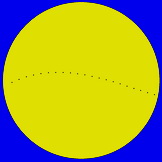 Hannover 2019 horizontal view |
Internet ProjectTransit of Mercury, November 11th, 2019 |
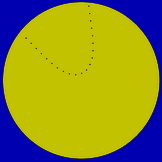 Buenos Aires 2019 horozontal view |
 |
 |
|---|---|
| (estas páginas en español) | (diese Seiten auf deutsch) |
On November 11, 2019, between 12:40 UT and 18:09 UT, a tiny black dot will pass the solar disc: A transit of Mercury, a quite rare event, will happen. The first part of the transit will be visible from Europe and Africa, its end from North America. The complete will be observable from South America only.
| The daylight side of the Earth (from where the transit may be observed) when the transit ... | ||
|---|---|---|
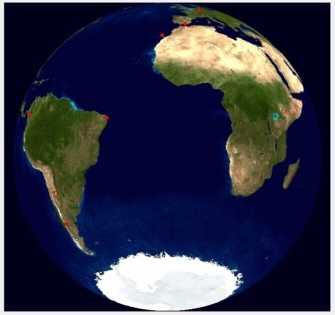 |
animation with Δt=30 min |
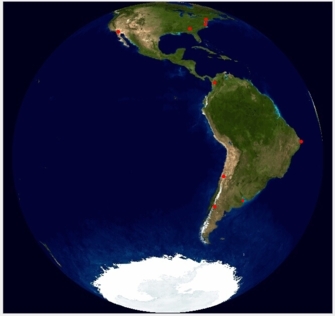 |
| ... starts (12:40 UT) | ... ends (18:09 UT) | |
Transits of Venus and Mercury played an essential role in the history of astronomy, because they offered the possibility of exactly measuring the distance between the sun and the earth, the so called Astronomical Unit (au). Nowadays, this aspect is no more scientifically relevant. Nevertheless, the observation and evaluation of transits are of outstanding importance for educational reasons because they offer the possibility of retracing a central astronomical experiment which during the 18th and 19th centuries occupied so many of the best scientists. The former necessity of travelling all around the world today can be replaced by international cooperation via internet. The position measurements can be done on photos and the quite complex procedure of evaluating nowadays are much less difficult by using transparent computer algorithms.
For those reasons, we organized projects to obtain "own" measures of the distance to the sun by using the past transits of Venus (2004 and 2012) and Mercury (2016). The coming transit of Mercury will be the last until 2032. Therefore, we will take the "last" chance to repeat the measurement of the au using a planetary transit which will be observable in North and South America from its beginning to the end. For Europe, the conditions are worse: The sun will already set at about 15:30 UT and the probability of clouds and rain is quite high.
The central effect that must be measured is the parallactic shift of the planet. That means that Mercury must be photographed in front of the sun exactly simultaneously from sites of mutual distances as large as possible. In order to be able to determine Mercury's position with respect to the sun the picture's orientation must be known (or determinable) with high accuracy.
In 2019, Mercury's geocentric distance will be larger than in 2016. Its apparent size and parallax effect will be smaller and the measurements will, therefore, be even more critical than three years ago. The following picture visualizes the effect:
| The size of the planetary parallactic shift | ||
|---|---|---|
 |
 |
 |
| Venus 2012 Essen - Melbourne |
Mercury 2016 Hannover - Caracas |
Mercury 2019 Hannover - Caracas |
Some participants of our transit project of 2016 will try to repeat the observations and measurements done during that project. But we hope that this "initial crew" will expand widely during the following months.
 |
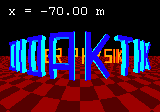 |
Editor: | Udo Backhaus |
last update: 2023-06-02 |  |